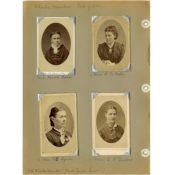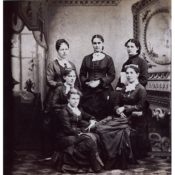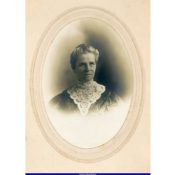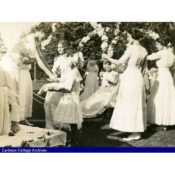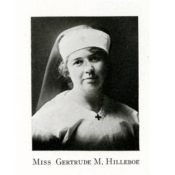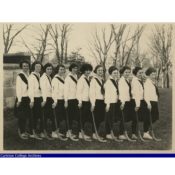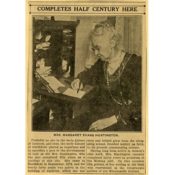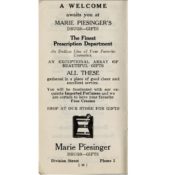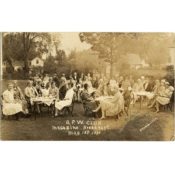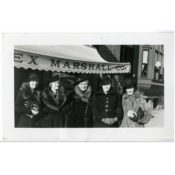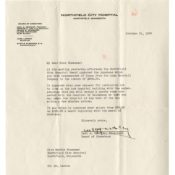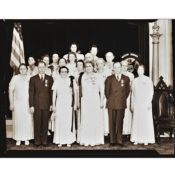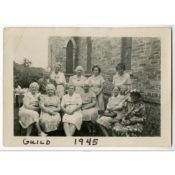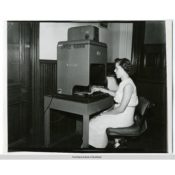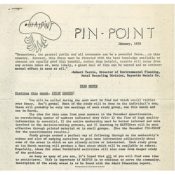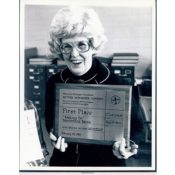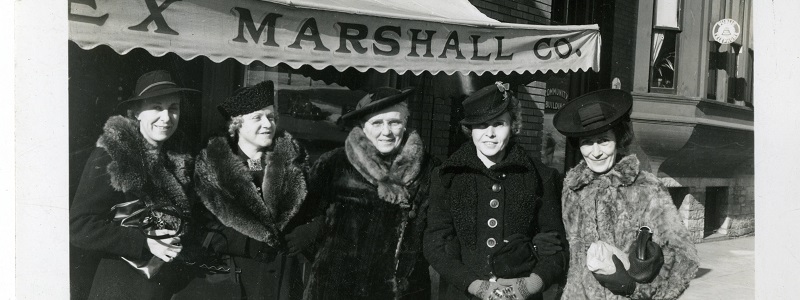
By Stephanie Hess, Northfield-Rice County Digital History Collection, January 2019
Women have contributed to Northfield’s history ever since Anne Loomis North moved here to join her husband, town founder John W. North, in 1856. The Norths developed a town based on their shared ideals, including women’s suffrage. They invited similar people to join them in their new town.
Women belonged to Northfield’s first community club: the Lyceum Society. Members of the Lyceum Society debated current events. After one debate in 1856, the group voted in favor of equal rights for women. Anne North and other women of Northfield also wrote the Lyceum’s newspaper and sang in its choir.
Both colleges in Northfield accepted women students from the beginning. In fact, Carleton College’s first graduating class of 1874 included a woman named Myra A. Brown. In 1893, Agnes Mellby was the first woman to graduate from St. Olaf College.
Women have also served as administrators and professors at both colleges. Carleton College’s first influential Dean of Women was Margaret Evans Huntington. Both Agnes Mellby and Gertrude Hilleboe were important early women at St. Olaf College. These college leaders also led various Northfield clubs and committees.
Women in the Northfield area joined women’s clubs to improve their community. Many joined Northfield’s Woman’s Christian Temperance Union (WCTU) chapter to prohibit alcohol and promote moral behavior. Others joined literary clubs, military organizations like the American Legion, church groups, businesswomen’s clubs, and university women’s clubs.
Some of these clubs supported a woman’s right to vote in political elections. Since 1875, women in Minnesota could vote in school board elections. By 1898, women could also vote for and serve on library boards. But they still were not allowed to vote for any other political office.
Women and men who believed in women’s suffrage—the right to vote—campaigned for full voting rights throughout the state, including Northfield. Many joined the Minnesota Woman Suffrage Association (MWSA) or similar organizations.
In the 1910s, suffragists also asked the federal government to allow women the right to vote. Congress finally passed the 19th Amendment of the U.S. Constitution on June 4, 1919. The Minnesota legislature ratified it on September 8, 1919. On August 26, 1920, the amendment became law. Northfield women were now able to vote in all elections.
Women’s work has changed over time in the Northfield area. In the early years, women were often isolated on frontier farms to grow crops and raise families. Women in town helped run businesses and stores formed by their husbands. A few ran their own shops, especially dressmakers. Other than teaching or nursing, women rarely had opportunities to work outside the home, family business, or farm.
Later, some women began working in the area mills and factories. Women also found jobs in offices as clerks and typists. Some became leaders in their field, including Marie Piesinger, a pioneering female pharmacist, and Myrtle Blesener, the superintendent of the hospital. When men left town due to World War I and II, women began to work outside the home in greater numbers than before. Following World War II, women’s roles in Northfield have continued to grow.
Women have shaped Northfield through their families, schools, businesses, churches, and community groups. By examining the history of women in the Northfield area, we gain a fuller understanding of the place.
Primary Sources
Discussion Questions
When you look at the individual items in the Northfield-Rice County Digital History Collection, use the zoom-in tool to view details in the images or more easily read the documents. Use the tab labeled “TEXT” to read full transcriptions of the documents.
Questions
- There have been many different types of women’s clubs in Northfield’s history, from church groups to social groups to educational or service groups. Why? Which one would you join, if any?
- Historically, why have some women felt the need to do work outside the home, whether it was through employment or volunteering? Has this changed today? How?
- What examples of women at work can you find in the set above? What fields were they employed in? Would you want any of those jobs?
- Are you surprised by any of the activities of women that are shown in the primary sources here? Why or why not?
- Open the Early Northfield scrapbook and using the text search box, type in the name of this Northfield woman: Emily Skinner (Mrs. M. W. Skinner). Read the clippings that you find. What do they tell you about the role and influence of this woman on the growth of Northfield? Can you find other stories about women in early Northfield in this scrapbook?
- Many of the Northfield groups formed during the Progressive era, when women (and men) focused on improving the morality of society. Other than women’s suffrage, how else did women try to improve their society in Northfield and elsewhere?
- Why do you think some people opposed women’s suffrage? Why did others support it?
- Northfield’s chapter of the Young Women’s Christian Association (YWCA) formed in 1887. Read its constitution and identify the goals of the organization were and who belonged to it. YWCA organizations still exist today. How do you think they have changed?
- In the 1970s, a group of women formed HATPIN (Housewives Alert to Pollution in Northfield) and worked to preserve the city’s natural areas. How was this more recent group similar to earlier women’s clubs? How was it different? Read their newsletters for more details.
- A 19th-century American stereotype claimed that women were responsible for being a good wife and mother in the “separate sphere” of the home, while men managed government and business outside the home. When did this separation between men and women begin to break down, and why? How did this change American society?
Beyond the Classroom
- Select one of the women represented in the sources above and research her life. Ask these sorts of questions: Who was she? When did she live here? What did she do in Northfield? How did she contribute to the Northfield community? Why is her life significant? Create a report, display, or something else to share the results of your research.
Related Items in the Northfield-Rice County Digital History Collection
“For Women Only” columns in the Northfield News, by Maggie Lee
Maggie Lee Recognition Dinner Program
Memoir of Kathryn Ripple Schrader
Northfield Lyceum constitution, bylaws, and minutes (note references to women participating and debates on women’s rights)
Order of the Eastern Star 50th Anniversary Program and History (with information on early leaders and prominent women members)
Records of the District #3 Rebekah’s Club (women’s group of the International Order of Odd Fellows)
Reminiscence from St. Olaf, by Elise Kittelsby Ytterboe
Reminiscences of Carleton’s first Dean of Women, Margaret Evans Huntington
St. John’s Lutheran Church Ladies’ Aid minutes, scrapbooks, and photographs
Additional Resources
Lesson Plans and Teacher Guides
Voting Rights for Women: Pro- and Anti-Suffrage. Lesson plan by EDSITEment, a project of the National Endowment for the Humanities. Web (accessed October 16, 2018).
Woman Suffrage and the 19th Amendment. National Archives Educator Resources. Web (accessed October 16, 2018). Reviewed by teachinghistory.org.
Women’s Suffrage. Teacher’s Guide by the Library of Congress. Web (accessed October 16, 2018).
Women’s Suffrage in the United States: Primary Sources and Activities. Minnesota Historical Society Primary Source Set, supported by the Library of Congress Teaching with Primary Sources program. Accessible online through MNHS’s Teaching with Primary Sources Videos and Sets page (accessed October 16, 2018).
Bibliography
Atkins, Annette. Creating Minnesota: A History from the Inside Out. St. Paul: Minnesota Historical Society Press, 2007.
Bingham, Marjorie. “Keeping at It: Minnesota Women.” In Minnesota in a Century of Change: the State and its People Since 1900, edited by Clifford Clark, 433-471. St. Paul: Minnesota Historical Society Press, 1989.
Gilman, Rhoda. “Women in Minnesota: Weaving the Web of Society in the North Star State.” MNopedia, Minnesota Historical Society. Web (accessed May 10, 2018).
Homstad, Torild. “Northfielders of Note: Marie Piesinger and Anna Dickie Olesen,” in Northfield Magazine, Vol. 1 No. 3, Fall 1987.
Hvistendahl, Susan. Historic Happenings, Vol. I, Vol. II, and Vol. III: Selected Entertainment Guide columns. Northfield, MN: Northfield Historical Society Press and The Entertainment Guide, 2014-2015.
Loetscher, Elizabeth. “Scandinavian Woman Suffrage Association.” MNopedia, Minnesota Historical Society. Web (accessed February 13, 2019).
Northfield Heritage Preservation Commission. Northfield: The History and Architecture of a Community. Northfield, MN: Northfield Printing, 1999.
Our Story: A Guide to the History of Northfield Minnesota. Northfield, MN: Northfield Historical Society Press, 2013.
Sauve, Jeff M., ed. Pioneer Women: Voices of Northfield’s Frontier, 1856-1876. Northfield, MN: Northfield Historical Society, 2009.
Schaeffer, Maia LeClair. “Women’s Suffrage in Minnesota” LibGuide, Minnesota Historical Society. 2018. Web (accessed June 14, 2018).
Stuhler, Barbara. “Organizing for the Vote: Leaders of Minnesota’s Woman Suffrage Movement.” Minnesota History Quarterly (Volume 54, No. 7, pp. 290-303). Available on the web (accessed September 19, 2018).
Weber, Eric. “Minnesota Woman Suffrage Association.” MNopedia, Minnesota Historical Society. Web (accessed June 13, 2018).
Primary Source Analysis
Here are some tips for analyzing the primary sources found above and throughout the DHC. For each source, ask students to indicate:
- the author’s point of view
- the author’s purpose
- historical context
- audience
For inquiry-based learning, ask students to:
- explain how a source tells its story and/or makes its argument
- explain the relationships between sources
- compare and contrast sources in terms of point of view and method
- support conclusions and interpretations with evidence
- identify questions for further investigation
Additional Tools
- Document Analysis Worksheets from the National Archives
- Teaching with Primary Sources Videos and Sets from the Minnesota Historical Society
- Using Primary Sources from the Library of Congress
Minnesota Education Standards
Here is a list of education standard codes for benchmarks that can be explored using this Primary Source Set.
- 0.4.1.2.1
- 1.4.1.2.1, 1.4.1.2.2, 1.4.2.4.1
- 2.4.1.1.1, 2.4.1.2.1, 2.4.2.4.2
- 3.4.1.1.2, 3.4.1.2.1, 3.4.2.5.1
- 5.4.1.2.1, 5.4.2.3.1
- 6.4.1.2.1, 6.4.4.20.3, 6.4.4.21.1
- 7.4.1.2.1, 7.4.4.18.3, 7.4.4.20.5
- 9.4.1.2.1, 9.4.4.18.4, 9.4.4.18.5, 9.4.4.21.6
- 1.8.7.7
- 2.8.7.7
- 3.2.7.7, 3.6.2.2, 3.6.7.7, 3.6.8.8, 3.8.2.2, 3.8.7.7, 3.8.8.8
- 4.2.7.7, 4.6.2.2, 4.6.7.7, 4.6.8.8, 4.8.2.2, 4.8.7.7, 4.8.8.8
- 5.2.7.7, 5.6.2.2, 5.6.7.7, 5.6.8.8, 5.8.2.2, 5.8.7.7, 5.8.8.8
- 6.12.1.1, 6.12.2.2, 6.12.4.4, 6.12.7.7, 6.12.9.9, 6.14.2.2, 6.14.7.7, 6.14.8.8
- 9.12.1.1, 9.12.2.2, 9.12.4.4, 9.12.7.7, 9.12.9.9, 9.14.2.2, 9.14.7.7, 9.14.8.8
- 11.12.1.1, 11.12.2.2, 11.12.4.4, 11.12.7.7, 11.12.9.9, 11.14.2.2, 11.14.7.7, 11.14.8.8
Send us feedback about this primary source set.
This publication was made possible in part by the people of Minnesota through a grant funded by an appropriation to the Minnesota Historical Society from the Minnesota Arts and Cultural Heritage Fund. Any views, findings, opinions, conclusions or recommendations expressed in this publication are those of the authors and do not necessarily represent those of the State of Minnesota, the Minnesota Historical Society, or the Minnesota Historic Resources Advisory Committee.


